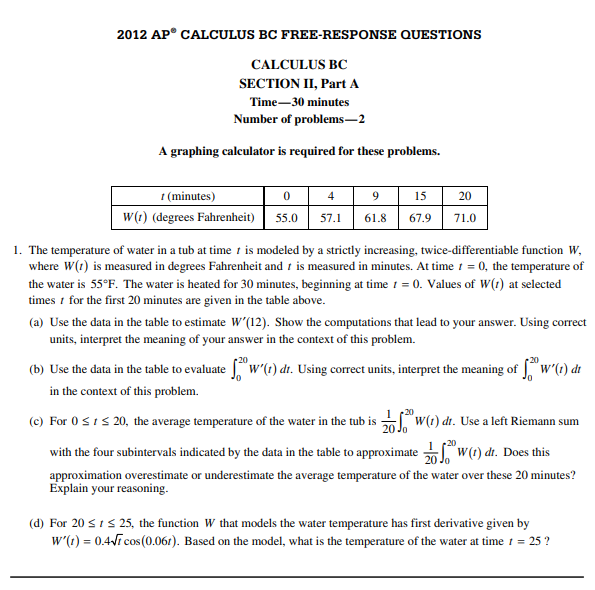AP Calculus BC 2012 Questions And Answers
Related Pages
Calculus Lessons & Past Papers
More AP Calculus Past Papers and Solutions
AP Calculus AB and BC FRQ
AP Calculus AB and BC MCQ
Questions And Worked Solutions For AP Calculus BC 2012
Click on the following image to get the complete paper of AP Calculus BC 2012 Free Response Questions. Scroll down the page for step-by-step solutions.

AP Calculus BC 2012 Free Response Questions - Complete Paper (pdf)
AP Calculus BC 2012 Free Response Questions - Scoring Guide (pdf)
- The temperature of water in a tub at time t is modeled by a strictly increasing, twice-differentiable function W, where W(t) is measured in degrees Fahrenheit and t is measured in minutes. At time t = 0, the temperature of the water is 55 °F. The water is heated for 30 minutes, beginning at time t = 0. Values of W(t) at selected times t for the first 20 minutes are given in the table above.
(a) Use the data in the table to estimate W′(12). Show the computations that lead to your answer. Using correct units, interpret the meaning of your answer in the context of this problem.
(b) Use the data in the table to evaluate . Using correct units, interpret the meaning of in the context of this problem.
(c) For 0 ≤ t ≤ 20, the average temperature of the water in the tub is . Use a left Riemann sum with the four subintervals indicated by the data in the table to approximate . Does this approximation overestimate or underestimate the average temperature of the water over these 20 minutes? Explain your reasoning.
(d) For 20 ≤ t ≤ 25, the function W that models the water temperature has first derivative given by W′(t) = 0.4 √t cos (0.06t). Based on the model, what is the temperature of the water at time t = 25 ? - For t ≥ 0, a particle is moving along a curve so that its position at time t is (x(t), y(t)). At time t 2, the particle is at position (1,5)
- Let f be the continuous function defined on [−4, 3] whose graph, consisting of three line segments and a
semicircle centered at the origin, is given above. Let g be the function given by .
(a) Find the values of g(2) and g(-2).
(b) For each of g′(-3) and g′′(-3) , find the value or state that it does not exist.
(c) Find the x-coordinate of each point at which the graph of g has a horizontal tangent line. For each of these points, determine whether g has a relative minimum, relative maximum, or neither a minimum nor a maximum at the point. Justify your answers.
(d) For -4 < x < 3, find all values of x for which the graph of g has a point of inflection. Explain your reasoning. - The function f is twice differentiable for x > 0 with f(1) = 15 and f’’(1) = 20. Values of f’’, the derivative of
f, are given for selected values of x in the table above.
(a) Write an equation for the line tangent to the graph of f at x 1. Use this line to approximate f(1.4). - The rate at which a baby bird gains weight is proportional to the difference between its adult weight and its
current weight. At time t = 0, when the bird is first weighed, its weight is 20 grams. If B(t) is the weight of the
bird, in grams, at time t days after it is first weighed, then
Let y = B(t) be the solution to the differential equation above with initial condition B(0) = 20.
(a) Is the bird gaining weight faster when it weighs 40 grams or when it weighs 70 grams? Explain your reasoning.
(b) Find in terms of B. Use to explain why the graph of B cannot resemble the following graph.
(c) Use separation of variables to find y = B(t), the particular solution to the differential equation with initial condition B(0) = 20. - The function g has derivatives of all orders, and the Maclaurin series for g is
Try out our new and fun Fraction Concoction Game.
Add and subtract fractions to make exciting fraction concoctions following a recipe. There are four levels of difficulty: Easy, medium, hard and insane. Practice the basics of fraction addition and subtraction or challenge yourself with the insane level.

We welcome your feedback, comments and questions about this site or page. Please submit your feedback or enquiries via our Feedback page.